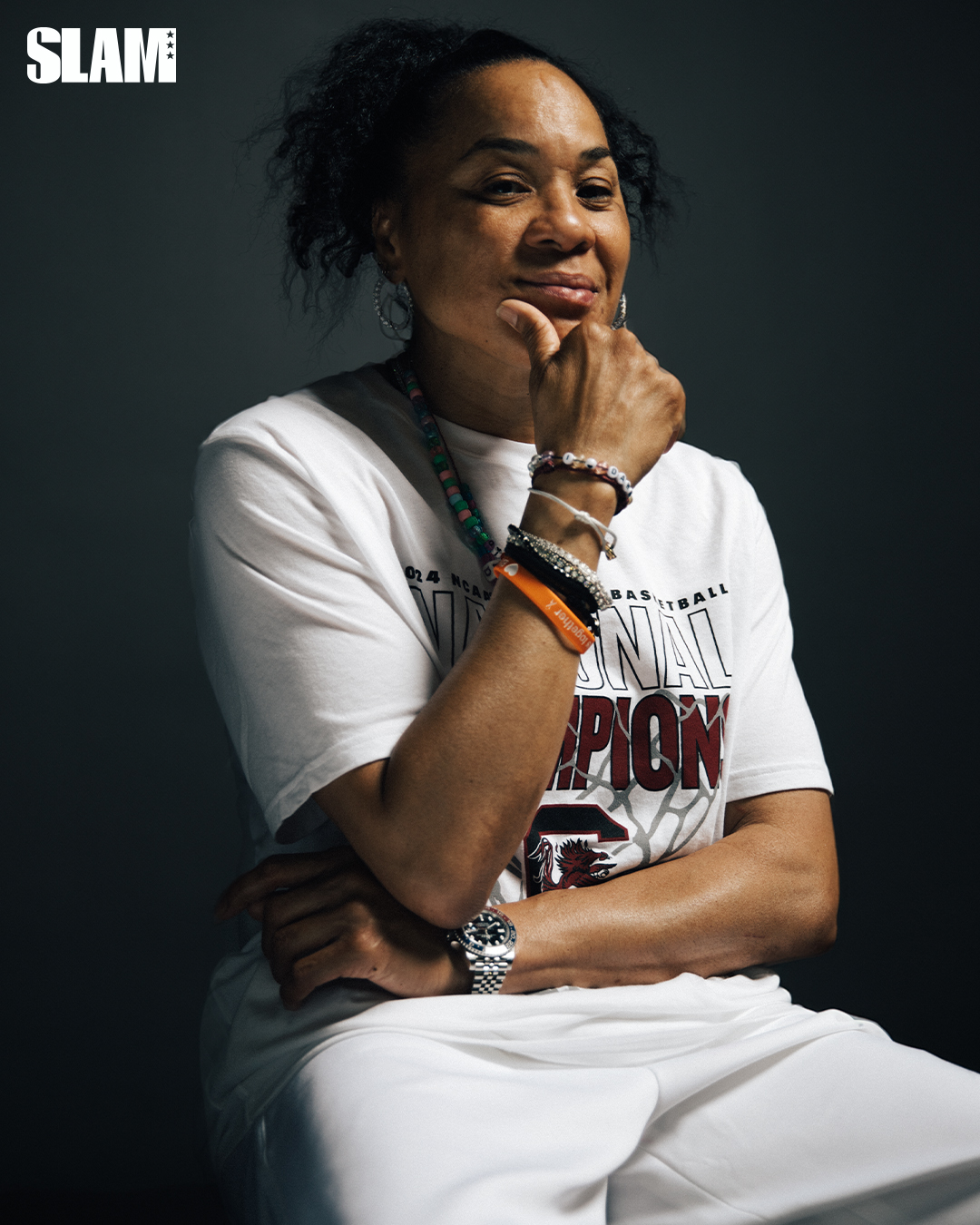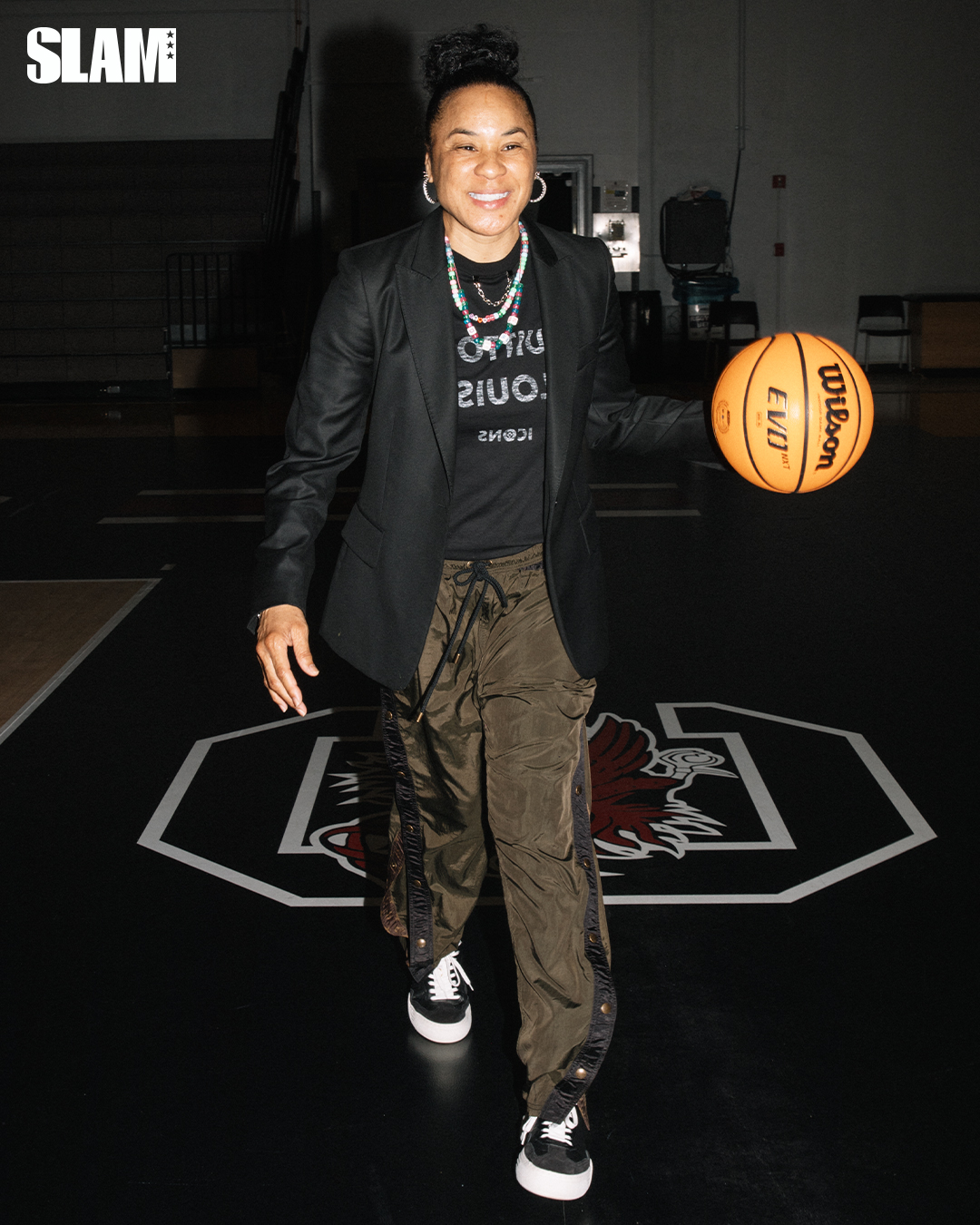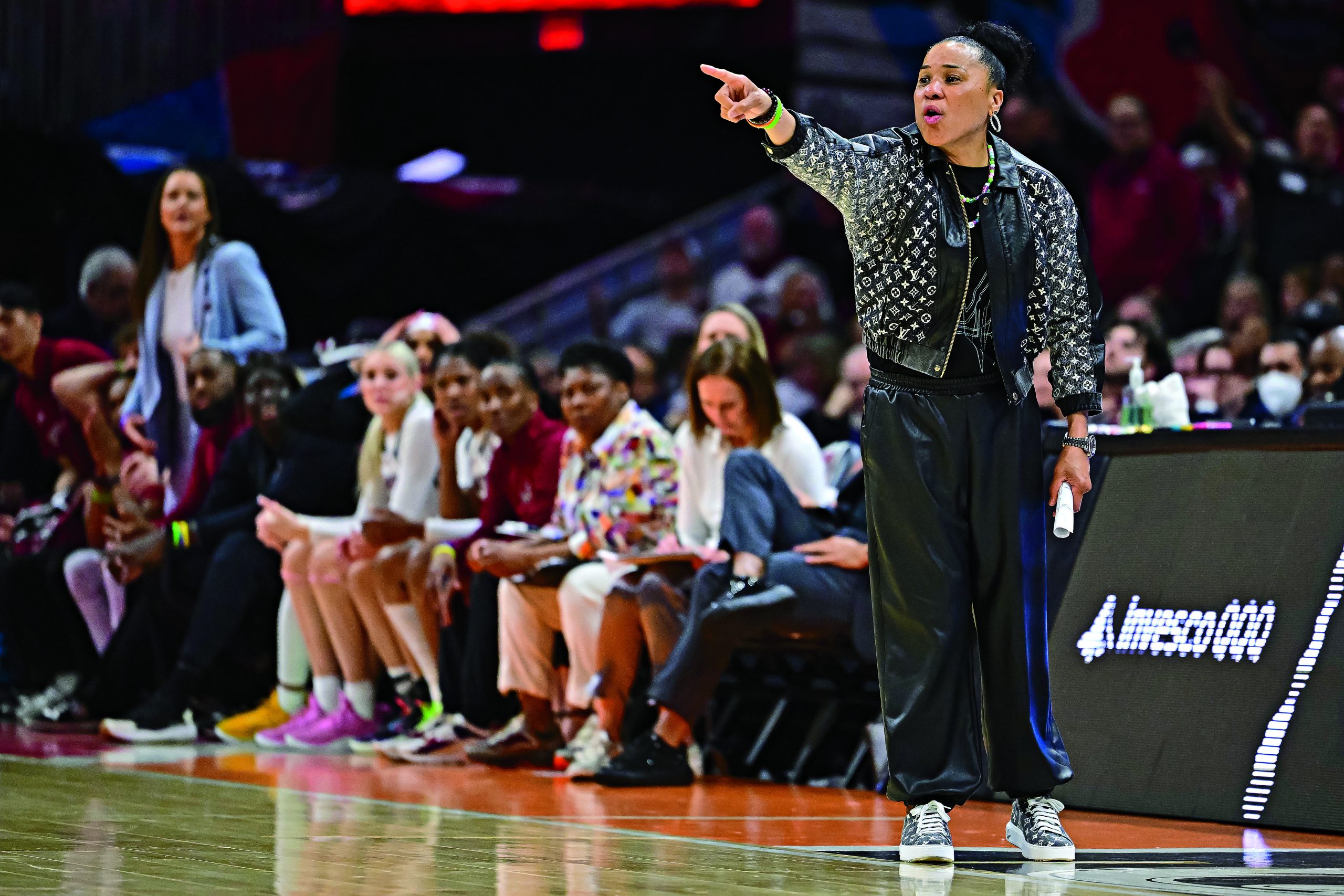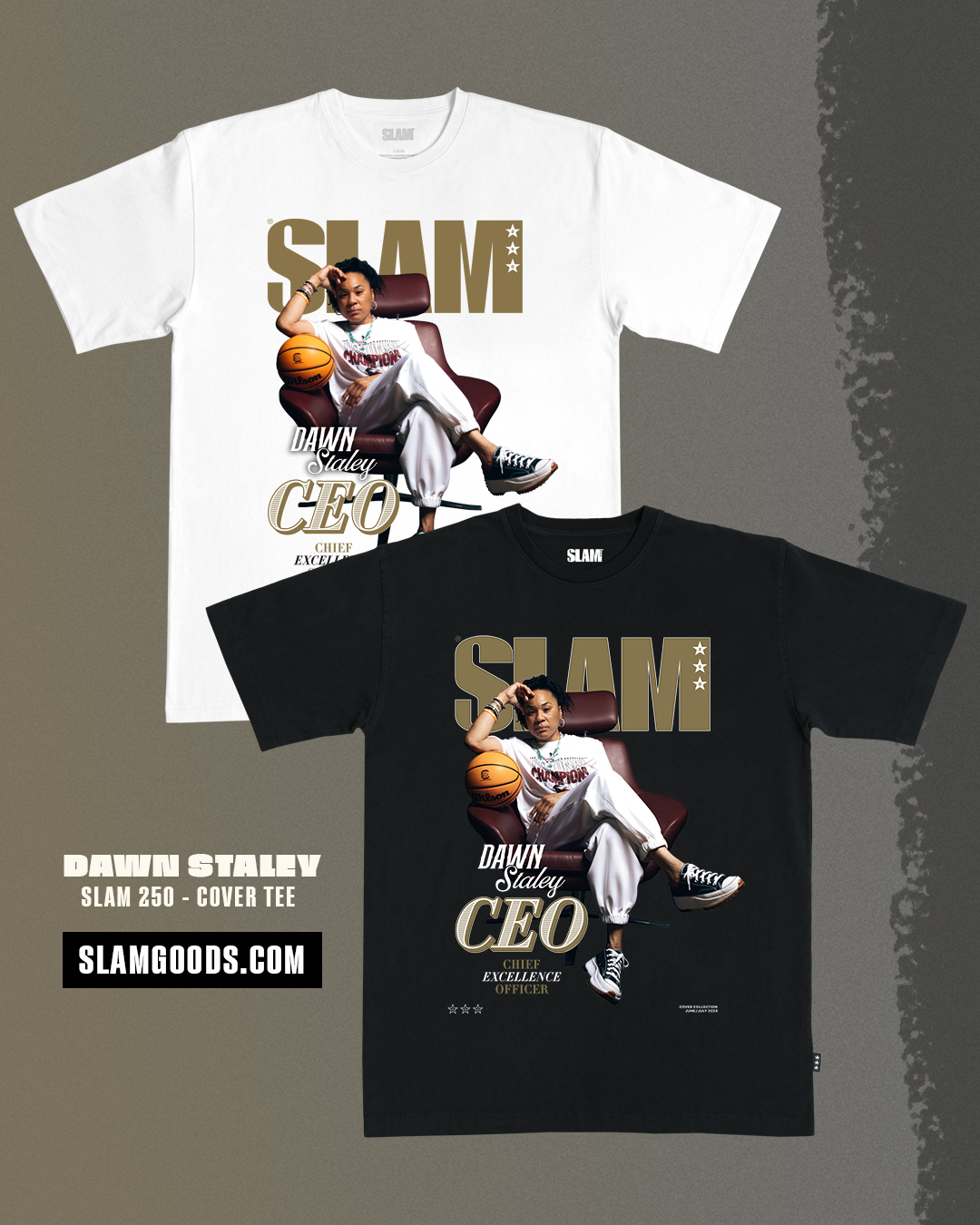Look up and the first things you’ll see inside South Carolina’s practice gym are the portraits of the players she’s coached, mentored, inspired: first-round WNBA draft picks including A’ja Wilson, Aliyah Boston, Alaina Coates, Allisha Gray, Kaela Davis, Laeticia Amihere, Mikiah Herbert Harrigan, Ty Harris and Zia Cooke. They serve as a reminder to anyone who steps in the gym that, even within an entire athletic program, The Dawn Staley Era is, and has always been, at the forefront. She’s the only Gamecocks basketball coach—men’s or women’s—to amass 300 wins, and the only Black head coach in hoops—men’s or women’s—to win multiple national championships. Look all around the gym and you’ll notice there are words plastered on the walls that reflect what she embodies, too: TOUGHNESS, PASSION, FAMILY.
When the legend herself walks in wearing an all-white fit, her aura and energy is mesmerizing. Her presence commands the entire room. This is the same visionary who just led her team to an undefeated season and the program’s third national championship, a feat very few expected them to accomplish. This is the very trailblazer who is the highest paid Black coach in all of women’s basketball. This is the Dawn Staley, the dream merchant who has led not just a program, but the culture, into a new day where no one can deny what she’s done and no one can doubt that she is one of the greats. It’s written in the banners, in the stars, and on this very cover. She is in charge. The CEO of excellence.
SLAM 250 featuring Dawn Staley is available now.
With her right hand man, Champ, prancing a few steps behind her, Staley exudes calm, cool and collected as she walks onto set. Biggie is blasting through the speakers in the background, serving as the perfect anthem for what we’re trying to capture: her aura, her energy and all that damn swaggggg. Not only is this Dawn’s first-ever solo SLAM cover, but it’s the first time ever that any coach has had their own cover for the magazine. Today is about capturing the legacy of someone who is way bigger than the box scores—but, if we are talkin’ hoops, a legacy that includes 38 straight wins this past season. The Gamecocks were out here destroying teams by upwards of 50, 60, nah, 80 points per game.
As legendary photographer Diwang Valdez snaps away, Staley, who is now wearing the team’s 2024 National Champions tee, effortlessly poses in front of the camera. Just when you think the flicks couldn’t get any more fly, Dawn turns things up with another outfit change. This time she’s rocking a black blazer, tearaway joggers and, of course, a crisp Louis Vuitton tee. She goes from giving soft smiles and playful banter to transforming, as she leans back into the chair she’s now sitting in, crosses her legs and rests her elbow on a basketball. She stares into the lens, giving the same look that we’ve seen from her on the court. It’s deeply methodical, poetic even. Right now, Dawn means business.
This is the face of someone who has personified strength, resilience and authenticity for decades. Here, she gives us a glimpse into her mind and her magic—a conversation that is as much about basketball as it is about how she sees people, her legacy, and—with true sincerity—herself.

SLAM: You’ve mentioned in the past how you didn’t really have an interest in coaching, at least early on. Can you bring us back to when you were playing in the WNBA and coaching at Temple at the same time?
Dawn Staley: One of the most gratifying moments of my life was to be able to play and then be able to coach all at the same time. Because it played on both sides of my brain and the passion was on full display. If any of the younger players in the WNBA ever have the opportunity to do both, they would find that it’s so fulfilling. You’re able to get out the aggression of playing while also being a dream merchant for younger players and giving them an experience that you are actually living. A lot of coaches have to go back in time to that place when they were playing, but when you’re able to do it in real time, it is an automatic respect from your players because they know you’re doing the very thing that you’re asking them to do and to be disciplined at.
SLAM: You often refer to yourself not just as a coach but a “dream merchant.” Can you elaborate on what you mean?
DS: Anybody that is coaching this game, that’s what you are. I know we try to figure out our purpose in coaching, and it’s just that: being a dream merchant for young people. Helping young people find their passion [and] work towards that. It’s not always basketball—it’s not. For 90 percent of them, it’s not basketball. It is figuring out what you want to do, because I want people to work in their passion. It is a lot easier to work in your passion if that’s what you do on a daily basis. The real world really is taxing. It pulls you in a lot of different directions and if you’re not passionate about it, you are not going to give it your full effort. And maybe half of you is good enough in some instances, but for you as a person, your fulfillment is most important.
So, what does a dream merchant do? That person guides, that person helps to navigate, that person is a listener [and] an observer. That person is someone that is trustworthy of not only the student-athlete but everybody that touches that student-athlete, because it’s not just a one-way street. All young people have people in their lives that impact them. I find that young people talk to their parents every single day…I think back to when I was their age, I probably talked to my mom or my dad maybe twice a month. And you know when that was? When the funds were low. But they talk to them every day, so I’m like, OK, well, I may have to change my style. I may have to pivot a little bit because I want to be the biggest voice in my players’ heads, and if it’s the parents that have access in that way, in talking to their daughters every day, [then] I gotta talk to the parents.

GET YOUR COPY OF SLAM 250 + COVER TEE
SLAM: Who were your mentors? And did any coaches inspire you?
DS: I really didn’t have coaching mentors. I’m more of a private person. I don’t like to show weakness, and that’s probably a downfall of mine, but it’s the very thing that keeps me going, because it has me working. It always has me preparing for the worst, and I don’t like to take my problems to anybody else. I will say I have people in my life that I bounce things off that [are not] as close to the game as probably some other coaches, and I like them to give me feedback from the outside looking in, because when it’s all said and done, I like to be covered. My mind works as a basketball coach most of the time, so I’m always looking for basketball things to teach lessons to our players because I believe that sometimes they learn better from that standpoint.
And then, if I get advice from somebody that’s not in the basketball world, I can balance that and make sure that I’m giving our players what I see, as well as what somebody else may see that I’m not covering.
SLAM: Has your approach to coaching changed at all over the years? Are there things that worked early in your career that may not work now and vice versa?
DS: We’re in an era where we have to pivot. What worked 24 years ago will not work today. I’ll say this: The core principles of who I am as a person and coach doesn’t change. [The] battles I fight? They change. Take for instance this year—my approach was entirely different than my approach in just the recent years. In recent years, we had a group of players that got it. They understood the assignment and what they needed to do and they executed on and off the court, so they gave us no issues. I was just able to be a basketball coach.
This year, they were different. They were younger, their approach was different. They were lackluster, they didn’t really have a plan as individuals—they may have thought they had a plan. Their plan was just to play more. You can approach it that way, but it’s shallow, so you gotta put something behind it. We worked from a place that we hadn’t worked from in a long time, which was, Hit the ground running. We couldn’t [even do that] because they couldn’t run, they were outta shape. They came in just thinking, I wanna play. I sat for a long time. It’s my time. Well, their time, and who they thought was taking their time, [the] approach was a lot different. Zia, Aliyah, Brea [Beal], they all came in shape. Every time that we had to come back in the summer, so we could hit the ground running…It was more of creating better discipline and habits, because they hadn’t formed it to the degree of them being ready to rock and roll. So, I looked at it as a challenge, and once I looked at it [as that], I got more passionate behind it because I’m drawn to challenges. It was cool because they did teach me [that] there are a number of ways to be successful and a number of ways to approach things.
One of the battles that I did not fight that I normally fight: if everybody had the same sweatsuit on, and one person didn’t, I knew that they spoke to that person. I knew it. I could see it, I’m looking at [it] and it looks strange to me…I approached it as a mistake that had been handled. But that’s one of the things I didn’t fight, because I knew this team had a way of delivering the message that I would deliver.

SLAM: As you mentioned, the start of the season was a little different for you. What do you attribute this year’s success to?
DS: We’ve had the best team in the country prior to this year, I would say for years. The best team in the country and this one ended up being the best team in the country by way of default, so to speak. But it was a way that was formed by them and I will give them all the credit because they could’ve balked, they could’ve said, I should be starting—for a while, they could’ve said, I’m the It. I should be starting. Tessa [Johnson could’ve been like], I could play with the best of them. Let me get some of Breezy’s time. Let me get some of Raven’s time. [But] they didn’t. Actually, the youngsters just allowed the older players to guide them to the point where they were so confident entering the basketball game that they knew that they were going to make an impact. And they kept holding each other accountable. Ashlyn [Watkins] found her superpower, and her superpower is on both sides of the basketball, but it was also leading. Her voice was prevalent in huddles, and it got to the point where they didn’t want to lose. It wasn’t even being undefeated, they just didn’t want to lose. It was nothing about winning each and every game, but in the moment of each game, they didn’t want to lose. So, they would listen to each other and they were very coachable, and then we just got momentum. We kept pushing through and then when we got to the Final Four, they were like, We gonna win this thing.
Before the national championship game, they were talking major cash ish. The coaches’ locker room is connected to the big locker room, and we don’t go in there [to] let them have their space. I’m too close to the situation, I don’t want to hear them, [but] they’re like, We’re going to kick their A, and I’m like, Lord, they don’t know what they don’t know. Either we’re going to get blown out, or we’re going to blow somebody out because they were talking. And I know they’re hyping themselves up, but as coaches, you know, we gotta go out there and face Caitlin [Clark] and them. Like, they got themselves here, they got momentum.
As coaches, too, we would ask each other, You drinking the Kool-Aid? We would literally ask each other. So, for the most part we were like, Nah, we ain’t drinking it. Towards the end of the year, we asked, How about now? You drinking the Kool-Aid? I’m like, I’m sippin’. I ain’t taking a big gulp, but I’m sippin’. Because they’re putting it on display. I think, just overall as I reflect, it was a super cool journey and environment to be around them. They just played loose. I told this to a friend, I said, “They played free.”…So, I think that was really kind of cool for them to take us coaches down their journey. It’s usually, like, our journey—how we want to direct them and guide them. Nah. Nah, we got on their train and we rode their coattails.

SLAM: Now that you’ve accomplished it all—going undefeated, winning your third chip—how does it feel?
DS: It feels great, like seriously. It’s unbelievable to me…[The] 2022 [team] looked the part. They looked the part, they played the part. They played just freer, but with pressure. And then this group was just unlike any of them. I don’t think anybody saw it coming. We didn’t see it coming, so that’s what I like about it. I’m sitting [here] and I’m happy…I want to share our story. I want to share the good, the bad, the ugly but also the likelihood of someone else doing what we did—I want to give them hope, because we didn’t look like a national championship team at the beginning of the season. We looked like most of the teams in the country, so we’re relatable to most of the teams. If we could do it, anybody could do it.
SLAM: Your legacy reaches far beyond Xs and Os, wins and losses. We could go on and on, but what do you, Dawn Staley, want your legacy to be?
DS: I want my legacy to be an “odds beater.” I am an odds beater. The odds said that I wouldn’t be an Olympian, I wouldn’t be the head coach of an Olympic team. To have coached 24 years in this game, I know that I don’t care about a personal legacy. I want to let my players talk about the legacy that they were able to feel every day from our coaching staff. I don’t have to say anything, they say it. Historically speaking, you don’t really hear my name as being a great coach, whether it’s X-ing and O-ing. I’m probably known to be a player’s coach, whatever that means. But to win three national championships, to not be an X and O coach and only be a player’s coach, I think we’re doing pretty good. If the X-ing and O-ing coaches aren’t winning national championships, I know they would probably flip it and be a player’s coach, if it produces national championships. I really don’t care about any of that, but what I do care about is our players, their experiences [and] their legacy, because the more of a legacy they have, it comes back. I just want to do right by our players.
SLAM: You’ve seen women’s basketball skyrocket from a business standpoint, starting from your playing days to what it is today. What has it been like to see this transformation in real time?
DS: Women’s basketball is super cool, now. I would say now. It was super cool to me when I was growing up playing it and going to college because I didn’t know what I didn’t know. Now that I know what I know about our game, one, we’ve been intentionally held back. I know that because it just doesn’t come out of nowhere. It seems like our game has just come out of nowhere and now everybody is falling in love with it, when we know different. We know that back when I was playing in ’88, in college, in ’89, people were watching. They would tune in. I know it because I know when I go to different places, I’m more known for playing at Virginia than anything. So, they were watching it.

So, what happens between then and now? Decision makers are making some really good calls when it comes to our game…They know that women’s basketball is a mainstay. So, the biggest difference now is we are being treated like a real sport. The good, the bad and the ugly because in sports you have storylines, like a Caitlin Clark. In our game you have storylines of us being undefeated, winning a national championship. You’ve got Juju [Watkins], Hannah [Hidalgo], MiLaysia [Fulwiley], all of these storylines that are being played out now because the fans want more and more and more. And now, finally, and maybe, it’s the new negotiated TV deal that is allowing us to continue to grow. Maybe there’s somebody in the room that’s making sure that we have different people telling our stories. You got Elle Duncan, Chiney Ogwumike, Aliyah Boston, [Andraya] Carter, Carolyn Peck…I thought that whole crew broke basketball down like no other. Wasn’t biased, because we gotta get the bias out of our game. So, you saw what happens when it’s unbiased. It was absolutely beautiful.
SLAM: You don’t seem like the type to chase milestones or history, it just sort of finds its way to you. With that being said, is there anything that you have your eyes set on before you bow out of coaching?
DS: Selfishly, it’s just one thing that I wanted out of this game: I wanted to be a Hall of Famer. So, I went in [to the Naismith Basketball Hall of Fame] in 2013 as a player. Now, I do want to go in as a coach.


Portraits by Diwang Valdez. Action photos via Getty Images.














